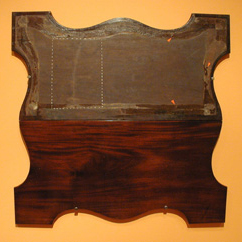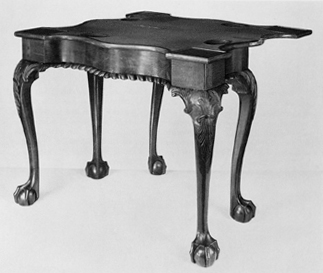 |
Re-used boards |

 |
Inappropriate color |
| Card
Table New York, 1760-1770 Mahogany Lent by the Winterthur Museum 1959.2843 |
 |
| The authentic, and skillfully crafted table was first illustrated in Joseph Downs’ 1952 catalog of the Winterthur collection |
 |
Lack of historical evidence
|
 |
Artifically colored surfaces |
 |
| The authentic, and skillfully crafted table was first illustrated in Joseph Downs’ 1952 catalog of the Winterthur collection |
As on the preceding fake card table, the supposedly New York card table on
the right consists of mostly new parts with an old rear rail and fly rail.
Similarly the design copies a well-known published form, the table on the
left. The authentic, and skillfully crafted table was first illustrated in
Joseph Downs’ 1952 catalog of the Winterthur collection, a book published
eight years before the Stones acquired their fake. The text and views shown
in Downs’ catalogue, shown above, provided most of what the faker needed
to know about the size, woods, and construction of the rear rail and drawer.
The knee acanthus is by the same hand that carved most of the fraudulent pieces
in the Chipstone collection. The design of this individual’s work varies
a great deal, but his techniques and lack of skill are relatively consistent.
The leaves have excessively deep convex flutes and rounded edges that appear
to have been finished with fine-grit sandpaper. Although a variety of abrasives
were available in the eighteenth century, most woodworkers used them to removed
irregularities from broad convex surfaces such as the gadrooned molding on
the front rail. In contrast, the carved leaves on the antique table to the
left shows no such abrasion. Instead, this eighteenth-century decoration was
crafted with razor-sharp. carving tools.